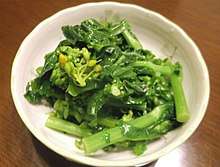Nanohana
Nanohana (菜の花, 'Vegetable flowers') is a cruciferous green vegetable, closely related to rapini and broccoli, which is commonly used in Japanese cuisine. The term nanohana specifically refers to the young shoots of the rapeseed plant (Brassica napus),[1][2] while the mature plant, which is used to produce rapeseed oil, is called aburana. The florets, stems, and leaves are all edible, and are commonly boiled and served with dashi (stock) and katsuobushi (bonito flakes).[3] The shoots may also be pickled or served as a salad with mustard.[1] A festival celebrating the spring bloom of nanohana, called Nanohana Matsuri, is held annually in Japan.[4]
| Nanohana | |
|---|---|
 | |
| Species | Brassica napus |
References
- Richard Hosking (24 February 2015). A Dictionary of Japanese Food: Ingredients & Culture. Tuttle Publishing. pp. 94–. ISBN 978-1-4629-0343-6.
- Donald C. Wood (October 2012). Ogata-Mura: Sowing Dissent and Reclaiming Identity in a Japanese Farming Village. Berghahn Books. p. 124. ISBN 978-0-85745-524-6.
- Itoh, Makiko (2013-02-22). "Ready for spring's fresh bounty". The Japan Times Online. ISSN 0447-5763. Retrieved 2020-01-19.
- Michael C. Brannigan (27 August 2015). Japan's March 2011 Disaster and Moral Grit: Our Inescapable In-between. Lexington Books. pp. 95–6. ISBN 978-0-7391-9669-4.
This article is issued from Wikipedia. The text is licensed under Creative Commons - Attribution - Sharealike. Additional terms may apply for the media files.